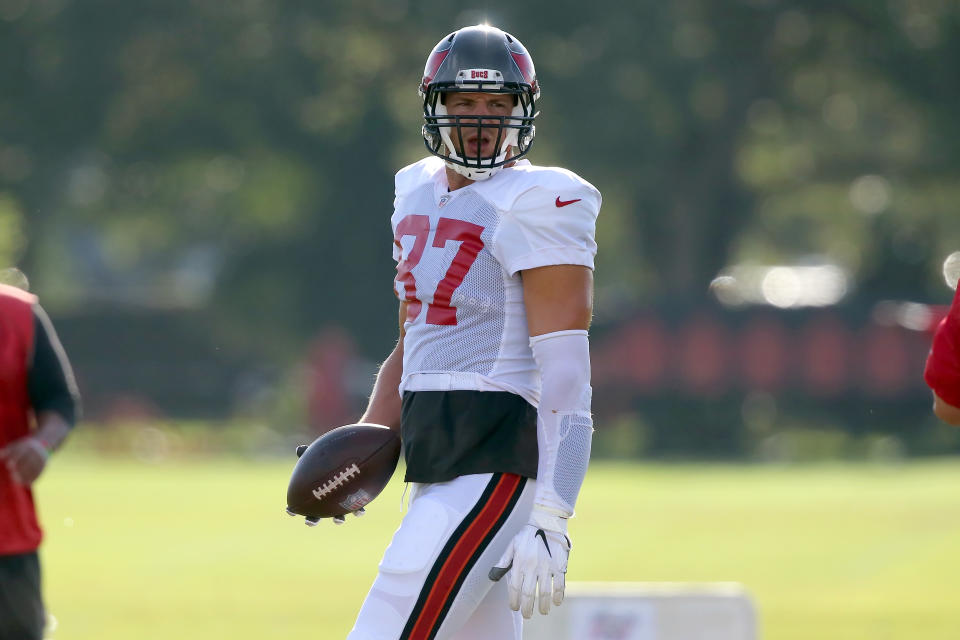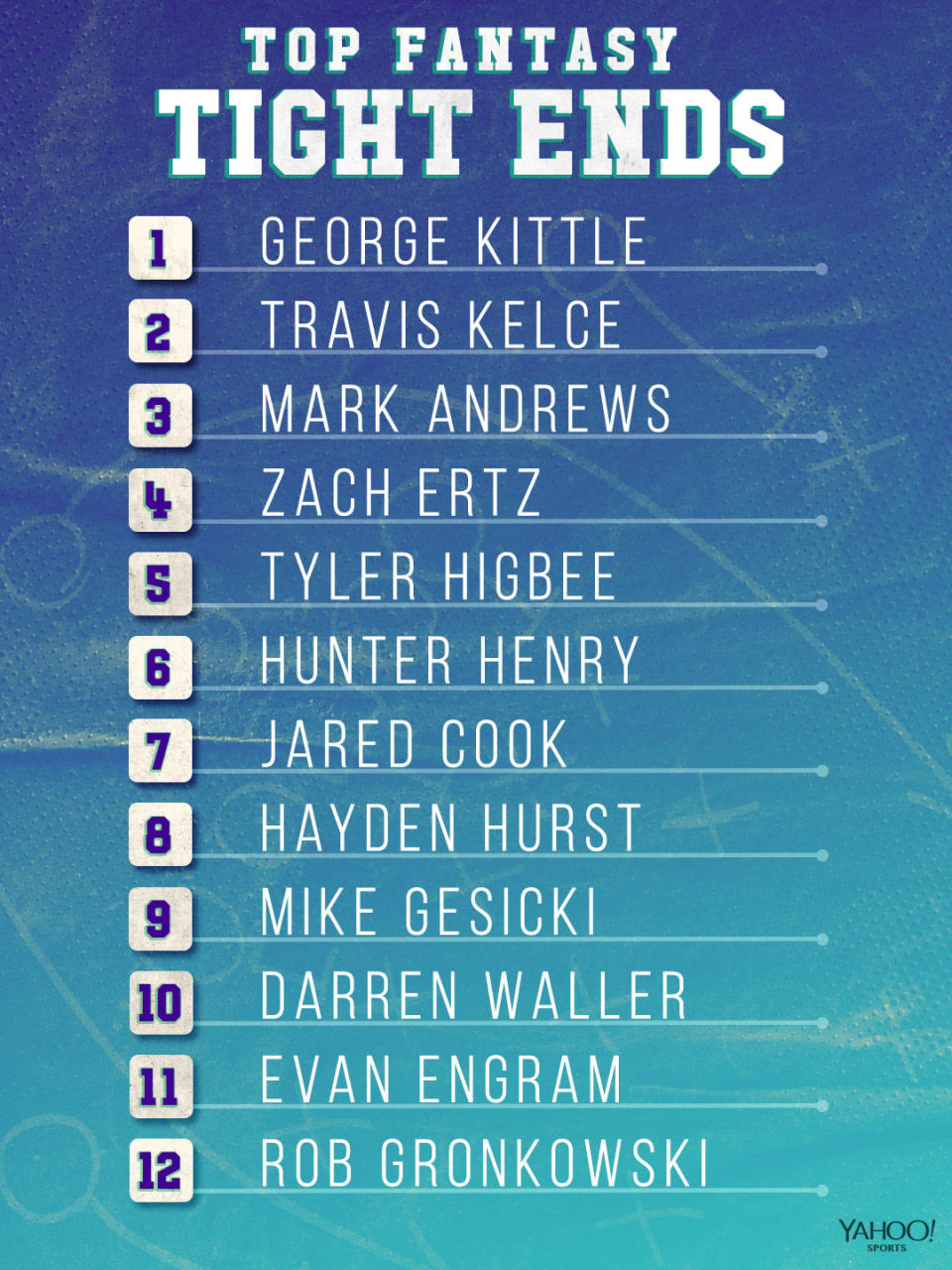2020 Fantasy Football Tight End Preview: Three key ways to attack this position in drafts
Current Tight End Landscape
A year ago I likened the tight end landscape to the aftermath of a Thanos finger snap.
While regular production via the position remained shallow overall, an infusion of young talent and increased utilization replenished the stock of intriguing options. In 2019, a total of eight TEs (with at least a 12 game sample) averaged over 10 fantasy points per game (half-point PPR), which was up from five in 2018 and three in 2017. Consequently, the chasm between the established elite and the burgeoning hopefuls isn’t as vast in 2020.
That means we have more tiers and more decisions to make.
Planted firmly at the apex of elite playmakers stand Travis Kelce and George Kittle, both of whom closed out 2019 with over 1,000 yards and 5 TDs apiece. Due to knee and ankle issues that sidelined Kittle for two games, Kelce (who played a full 16-game slate for the second consecutive season) ultimately amassed more fantasy points. On a weekly basis, however, only one-tenth of a point separated the two in terms of fantasy points per game. As such, there’s been some debate among drafters about how to rank these two mega-producers.
Per the SoS metric proprietary to 4for4, Kittle has an advantageous strength of schedule. Meanwhile, Kelce offers consistency while being additionally blessed by the Patrick Mahomes effect. Whether managers choose to invest in Kittle’s YAC (569 yards, TE1) or Kelce’s air yards (831 yards, TE1) the exchange is steep, as both players require a second-round pick.
A second tier of players offering proven talent and dependable-enough usage begin to come off draft boards from rounds 4 through 6. At the top of this next grouping is Mark Andrews (4.2), followed by Zach Ertz (5.1) and Darren Waller (6.4). All three of these prospects benefited from being their respective QB’s most relied upon pass-catchers. Andrews broke out in 2019, drawing 20 deep looks (TE1) and scoring 10 TDs (TE1). Meanwhile, Ertz remained heavily involved, clearing a snap share of over 80 percent and posting top-5 fantasy numbers for his third consecutive campaign. While Waller saw triple-digit targets last season, his situation heading into 2020 is less favorable. Not only is he attached to a less inspiring QB, but his volume figures to suffer with Henry Ruggs, Bryan Edwards, and Lynn Bowden joining the squad.
Over the next four rounds (7-11-ish) two different tiers appear to mesh together. The first includes three undoubtedly talented but seemingly injury-prone players, while the second anticipates a triad of competitors picking up where they left off last winter.
Hunter Henry (7.4) leads off the “fit but fragile” grouping. An outstanding athlete with ace efficiency that could buoy either Tyrod Taylor or Justin Herbert, the 25-year-old has played 41 games over his four seasons in the NFL (averaging 10.25 contests per year). Similarly, Evan Engram (9.5) has averaged 11.3 games per season since 2017 and is coming off a Lisfranc surgery, but has the athleticism (89th percentile SPARQ-x) and receiving ability (80% route participation, TE3) to dominate. Finally, Gronk (8.2) — who has proven his otherworldliness by averaging 13.3 fantasy points per effort over his nine-year career — has come out of retirement after one year away from the game. It remains to be seen whether he and the GOAT still got it or whether the physical toll of 20 concussions and nine surgeries will prove too much to overcome.

Looking to build on the success of their respective 2019 efforts are Tyler Higbee, Austin Hooper, and Jared Cook. Despite a notably small sample size, fans of the virtual game remain enamored with Higbee’s December to remember (8.6 receptions and 104.4 yards per game from Weeks 13-17), selecting him in the seventh round (just behind the aforementioned Henry). About a round later (near-ish to Gronk) perennial late-bloomer Jared Cook is often rostered. Attached to a high-octane offense and with little competition for targets, the 33-year-old boasts the highest floor of available late(r) round prospects. Rounding things out is Austin Hooper (11.4) who smashed in Atlanta, posting back-to-back TE6 fantasy finishes. Now in Cleveland, however, he’ll have to contend with an abbreviated offseason, a decidedly more run-focused scheme, and crowded stable of pass-catchers.
At the top of the double-digit rounds is where the NEXT BIG THING is likely to be found. Consider this the tier of burgeoning breakouts …
The favorite to “pop” among this next grouping is Hayden Hurst (11.5), who is expected to fill the role left by the previously mentioned Austin Hooper. While the former first-round draft pick remains unproven, his situation is brimming with undeniable upside. Close behind Hurst is Mike Gesicki (13.2), another hopeful from the 2018 draft class. Consistently deployed out of the slot and utilized more as a receiver than a traditional tight end in 2019, Gesicki posted top-seven numbers in route participation (71.6%) and total targets (nearly six per game).
Optimism for young players continues in Round 13 with former college teammates Noah Fant and T.J. Hockenson. Whether it’s Fant (13.3) emerging as a super-charged security blanket for Drew Lock (the two hooked up for 10-188-1 from Weeks 13-17 after Lock was named the starter), or Hockenson (13.4) staying healthy and making good on his red zone opportunities (he amassed five RZ looks over the first month of the season before being concussed in Week 4), both have promise.
Closing out the last of the upside plays in Round 13, Jonnu Smith and O.J. Howard are both players with intriguing ability but situations that could potentially cap their usage. Comped to Delanie Walker throughout the scouting process, Jonnu Smith enters 2020 as the Titans undisputed TE1. After Walker went down in Week 7, Smith’s routes run per week jumped by 47 percent (16.6/gm) and he showed off compelling YAC ability (277 yards, TE8). In Tennessee’s run-focused offense, however, his opportunities are limited. (Oh, and also, the Howard truthers continue their #taeklock.)
Finally, in the 14th round, darts are thrown at the remaining seven or so stragglers. Some managers are intrigued by well-positioned but far from flashy vets like Jack Doyle, Eric Ebron, and Blake Jarwin. Others believe in the post-hype appeal of Chris Herndon or that Ian Thomas is due for his glow-up. Some are even charmed by Dallas Goedert’s spike in snap percentage (70%) as well as Philly’s increased usage of two-TE sets. Regardless of the reasons, FF enthusiasts waiting on the position appear to have embraced the volatility of it and understand the concept of streaming.
Big-Picture Strategy
Prior to 2020 and the upsurge of talent outlined above, TE strategy was generally limited to two schools of thought. The first: De-prioritizing the position, instead choosing to focus on RB in the early rounds and then swing to TE late in drafts. Since most leagues only start one TE per team, this allowed managers to weigh the matchups and “stream” players from week-to-week.
Others, however, desired an edge at the position and preferred to lean into the consistent production (theoretically) provided by elite/early round talent.
Interestingly, and likely due to the evolving landscape, more managers are arriving at a third option. Per the below poll, instead of approaching the position in an all-or-nothing manner, a solid subset of the fantasy community decided to split the difference:
Which best describes your approach to drafting the TE position in #fantasyfootball (.5 PPR/not premium)?
— Liz Loza (@LizLoza_FF) August 4, 2020
Here are the results of three different mock drafts I performed utilizing all three strategies (12-teams, half-point PPR). Pick your favorite!
Drafting 1.03 - Prioritizing an elite TE:
QB: Matt Ryan
WR: Cooper Kupp
WR: Calvin Ridley
RB: Alvin Kamara
RB: Austin Ekeler
TE: *George Kittle
W/R/T: Todd Gurley
K: Zane Gonzalez
DEF: Minnesota
BN: David Montgomery
BN: D.J. Chark
BN: Michael Gallup
BN: Jordan Howard
BN: Darius Slayton
BN: Tony Pollard
*The first TE off the board, selected two spots ahead of Travis Kelce
Drafting 1.08 - Targeting TE in Rounds 5 - 8:
QB: Drew Brees
WR: JuJu Smith-Schuster
WR: Keenan Allen
RB: Clyde Edwards-Helaire
RB: Nick Chubb
TE: *Tyler Higbee
W/R/T: Jonathan Taylor
K: Jake Elliot
DEF: New Orleans
BN: Marvin Jones
BN: Diontae Johnson
BN: Tarik Cohen
BN: Latavius Murray
BN: Christian Kirk
BN: Darrel Williams
*Rostered in the 6th round, Higbee was the 5th TE off the board (behind Ertz who went in Round 4 and ahead of Darren Waller, who went seven spots later at the end of the 6th round). His selection aligned with the Yahoo Consensus rankings.
Drafting 1.06 - Waiting on TE until the double-digit rounds:
QB: Carson Wentz
WR: Chris Godwin
WR: Terry McLaurin
RB: Dalvin Cook
RB: Chris Carson
TE: *Austin Hooper
W/R/T: D'Andre Swift
K: Michael Badgley
DEF: Denver
BN: Kareem Hunt
BN: Diontae Johnson
BN: Darius Slayton
BN: Alexander Mattison
BN: Zack Moss
BN: *Chris Herndon
*Mike Gesicki flew off the board at 7.10 and Hayden Hurst went ONE spot ahead of Hooper in the 10th round (10.6). I grabbed Herndon at 13.6 to illustrate his late-round availability.
Fantasy Top-12

Draft Steal(s)/Draft bust(s)
Draft Steal:
I am growing increasingly fond of Hayden Hurst. While he’s admittedly unproven, his skill set, situation, and ADP all coalesce into a delicious value sandwich. A natural hands catcher with fluid athleticism and a robust frame (6-foot-5, 250 pounds), Hurst was picked by the Ravens in the first round of the 2018 draft. The 27-year-old gets knocked for being “old,” but it’s worth mentioning that he was drafted by the Pittsburgh Pirates in 2012 and played minor league ball for two years before joining the Gamecocks as a walk-on. Hurst has repeatedly proven that when given a shot, he’ll rise to the occasion. In fact, that’s exactly what his former teammate and draft classmate Mark Andrews said in a recent press conference.
It’s simplistic to believe that Hursts’ 2020 production will result in a copy-and-paste equivalent of Hooper’s stat lines from the past two years. Yet, there’s no denying that Dirk Koetter has an affinity for the position and knows how to unlock potential, having done it with Tony Gonzalez, Cameron Brate, and the aforementioned Hooper. Given his physical tools, lit offense, and play caller, Hurst has the potential to flirt with top-five fantasy numbers.
Draft Bust:
I’m regrettably out on Waller. Not because I don’t love the player or his story, but because I don’t think it’s possible for him to repeat his 2019 production given the Raiders recent additions. Waller balled out over the first two months of last season, recording two 100+ yard outings, scoring 3 TDs, and managing five top-10 fantasy performances. However, during that time, Tyrell Williams was playing through hip and foot injuries while rookie slot receiver Hunter Renfrow adjusted to life in the pros. In fact, once Renfrow was established, Waller’s production — particularly in the red zone — took a hit. It seems unlikely he’ll ROI of a fifth/sixth-round draft pick given the increased number of mouths to feed.
One-Sentence Gameplan
Whether you lock up the position with a stud in the second round (Kittle or Kelce) or target a potential breakout in the early double-digit rounds (Hurst or Gesicki), take comfort in knowing that undrafted sleepers will emerge as the season progresses.
Who are your favorite TE targets in 2020? Connect with Liz on social @LizLoza_FF.

 Yahoo Sports
Yahoo Sports